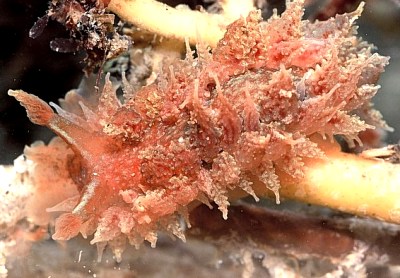
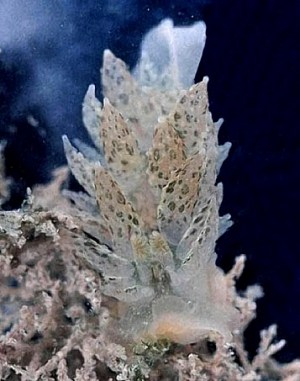
Dirona picta
MacFarland in Cockerell & Eliot, 1905
Order: NUDIBRANCHIA
Suborder: ARMININA
Family: Dironidae
DISTRIBUTION
Northern Oregon, USA to Baja California Sur, Mexico. Also reported from Japan.
PHOTO
UPPER: Naples Reef, Santa Barbara County, California, subtidal. Photo: Todd Huspeni.
LOWER: specimen crawling onto its bryozoan prey,
Scrupocellaria californica, Punta Gorda, northern California. Photo: Jeff Goddard.
Like its close relatives, Dirona aurantia and Dirona albolineata, Dirona picta feeds on arborescent bryozoans. However, with its tuberculate cerata and more complex color pattern, Dirona picta is highly cryptic on its prey, while its congeners are conspicuously colored. The body color of Dirona picta varies from tan to orange brown to greenish, possibly as a result of diet.
Dirona picta grows to about 40mm in length, lays bundled white egg cords similar to those of its congeners, and has planktotrophic larval development (Goddard, 1992, personal observations). Dirona picta ranges from Cape Meares, on the northern Oregon coast (Goddard, 1997) to Puerto Rompiente, Baja California Sur, Mexico (Farmer & Collier, 1963). Also known from the northern Gulf of California and Japan (McDonald, 1983).
References:
• Farmer, W. M. & C. L. Collier. 1963. Notes on the Opisthobranchia of Baja California, Mexico, with range extensions. The Veliger, 6(2): 62-63.
• Goddard, J.H.R. 1987. Observations on the opisthobranch mollusks of Punta Gorda, California, with notes on the distribution and biology of Crimora coneja. The Veliger, 29(3): 267-273.
Goddard, J. H. R. 1992. Patterns of development in nudibranch molluscs from the northeast Pacific Ocean, with regional comparisons. Ph.D. Dissertation, University of Oregon, Eugene, Oregon.
• Goddard, J. H. R. 1997. Range extensions of eight northeastern Pacific nudibranchs. Opisthobranch Newsletter, 23(4): 13.
• Goddard, J.H.R. 1998. A summary of the prey of nudibranch molluscs from Cape Arago, Oregon. Opisthobranch Newsletter, 24(2): 11-14.
• McDonald, G.W. 1983. A review of the nudibranchs of the California coast. Malacologia, 24(1-2): 114-276.
• McDonald, G.R. & J.W. Nybakken. 1978. Additional notes on the food of some California nudibranchs with a summary of known food habits of California species. The Veliger, 21(1): 110-119.
Goddard, J.H.R., 2000 (July 12) Dirona picta MacFarland in Cockerell & Eliot, 1905. [In] Sea Slug Forum. Australian Museum, Sydney. Available from http://www.seaslugforum.net/find/diropict
Related messages
Dirona picta from California
November 26, 2008
From: Clinton Bauder
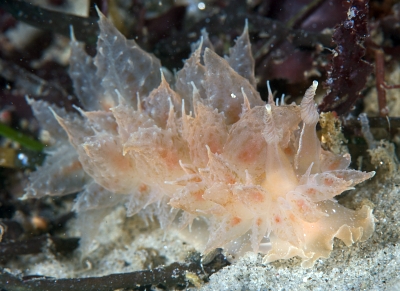
Concerning message #21349:
Hi Bill,
So I don't know how it works in Australia but here in California a stressful day at the office combined with a favorable weather forecast often means it's time to do a night dive. Tuesday's dive at the Monterey Breakwater was most notable for the interesting crabs and shrimps we found, up until the end of the dive when buddy Matt found two Dirona picta. This animal is rather rare in Monterey and I've only seen it once before. They were found in a mat of kelp and sea grass that was floating around on the sand. I'll admit to moving the slugs to the adjacent sand for better photos before returning them to the "salad" kelp.
Locality: Monterey Breakwater, 10 meters, California, USA, Pacific, 18 November 2008, Sandy Bottom. Length: 50 mm. Photographer: Clinton Bauder.
Clinton
gecko1@apple.com

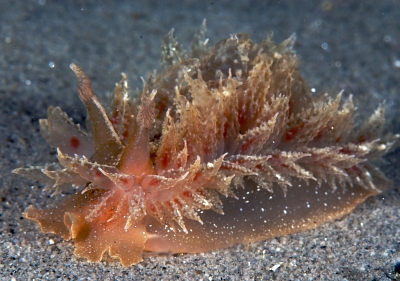

Hi Clinton,
Great shots, and yes this species is fairly uncommon. The color varies widely from white to brown as in your specimen to green below Ensenada, Mexico. This species feeds on arborescent bryozoans, which were likely rolling around in the soup too.
Thanks for sharing,
Dave Behrens
Re: Dirona picta from California
February 18, 2008
From: Dave Washburn
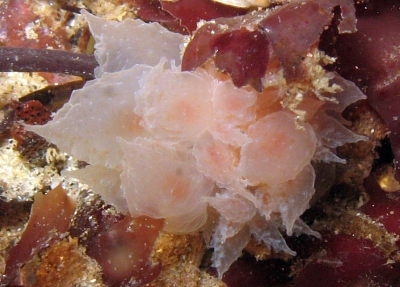
Concerning message #5233:
We found this white version of Dirona picta in Monterey Bay on 22 January 2008. We were following the big pipe that leads out to the Metridium field and spotted him right on the pipe itself. We had no idea what he was, a friend had to consult Dave Behrens directly to get the ID.
Locality: Monterey Bay, 25 feet, California, USA, Pacific Ocean, 22 January 2008, On an old cannery discharge pipe. Length: 1.5 inches. Photographer: Dave & Malinda Washburn.
Dave Washburn
dwashbur@nyx.net



Dear Dave,
Yes indeed. This species is highly variable in color, coming in white, tan, golden brown, grey and even a green variant. The really characteristic feature about this Dirona is the tuberculate cerata. Bill has provided us some close-ups showing this detail. Note that some of the tubercules are even bifid. These can be seen along the edge of the spatulate shaped cerata.
Good show,
Dave Behrens
Dirona picta from California
February 18, 2004
From: Joseph Dougherty

Hello.
I'm hoping someone can help shed some light on the identity of this Dendronotus. It doesn't quite look like anything in Behren's book (1991). I haven't been able to uncover anything on the internet that looks like this specimen. Is this a variant of D. frondosus? I looked at a bunch of D. frondosus images and they just don't look quite like this.
This animal was photographed in Monterey Bay. It is as large as D. iris, and that is what I initially thought it was as I swam up to it, since they are common in the area I was diving. However, there are tubercles everywhere on this thing.
Unfortunately, I shoot with a Nikonos and I had the fixed macro setup on the camera, so I could not fit a whole body shot into the frame. But this individual was at least 12cm long (that's a conservative estimate). I'd appreciate any ID help anyone can offer.
Thanks!
Joseph Dougherty
josephd@ecology.org
Dougherty, J., 2004 (Feb 18) Dirona picta from California. [Message in] Sea Slug Forum. Australian Museum, Sydney. Available from http://www.seaslugforum.net/find/12227
Dear Joseph,
Nudibranchs have a terrible habit of looking like other species in quite different families. This is Dirona picta. One clue to its identity is the shape of the rhinophores. In species of Dendronotus, like all dendronotoideans, the rhinophores stalk is enclosed in a sheath, usually with a papillate collar. As you can see this is absent in your animal.
Best wishes
Bill Rudman
Dirona picta from San Miguel, Calif.
August 8, 2002
From: Bruce Wight

We just got back [July 2002] from a great macro trip to San Miguel Island, California. As usual, the place was crawling with branchs. Here is a photo of a beautiful Dirona picta for your enjoyment.
Thanks,
Bruce Wight
bwproductions@earthlink.net
Wight. B., 2002 (Aug 8) Dirona picta from San Miguel, Calif.. [Message in] Sea Slug Forum. Australian Museum, Sydney. Available from http://www.seaslugforum.net/find/7706Thanks Bruce,
Bill Rudman
Dirona picta from California
September 9, 2001
From: Bruce Wight
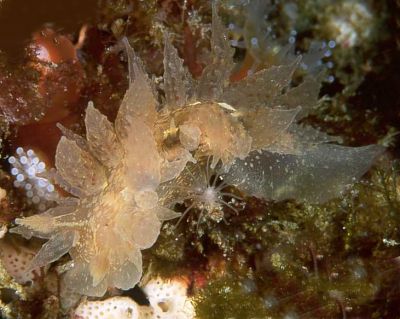
Hi guys,
Saw my first Dirona picta at Webster's Point at Santa Barbara Island, California, last Friday [31 August, 2001]. They are a beautifully textured nudibranch. I though you might like to see a couple of the images.
Take care,
Bruce
bwproductions@earthlink.net


Thanks Bruce,
Sometimes subtlety and form do indeed beat bright colours.
Best wishes,
Bill Rudman
Dirona picta from California
July 13, 2000
From: Jeff Goddard


Hi Bill,
Here are two photos and a brief account of the biology of Dirona picta for The Forum. The top photo is by Todd Huspeni of a specimen collected subtidally from Naples Reef, Santa Barbara County, California. The lower photo is of a specimen crawling onto its bryozoan prey, Scrupocellaria californica from Punta Gorda in northern California.
Best wishes,
Jeff
goddard@lifesci.ucsb.edu
Goddard, J., 2000 (Jul 13) Dirona picta from California. [Message in] Sea Slug Forum. Australian Museum, Sydney. Available from http://www.seaslugforum.net/find/2691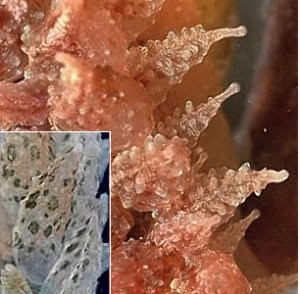
Thanks Jeff,
I am fascinated by the 'cerata' in D. picta, which I have enlarged views of alongside. If they belonged to an aeolid I would seriously consider looking for some symbiotic plant tissue. Compare them with Phyllodesmium crypticum for general shape. The lower photo with green patches looks very like the brown 'gardens' of zooxanthellae found in Phyllodesmium longicirrum.
It would be interesting to have a look at what is making the greenish markings.
Best wishes,
Bill Rudman.
